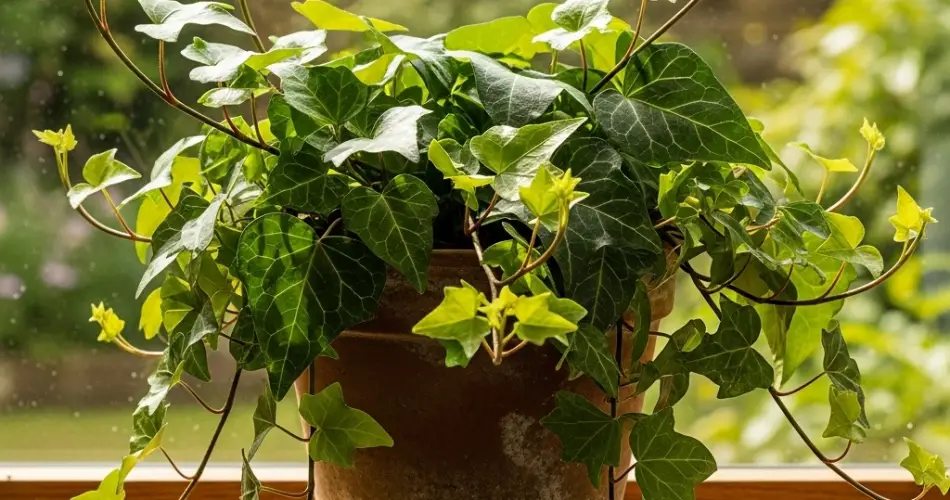English ivy (Hedera helix) is a versatile and attractive houseplant, prized for its trailing vines, lush green leaves, and ability to adapt to indoor conditions. It adds charm to shelves, hanging baskets, and planters, making it a favorite among plant enthusiasts. While English ivy is generally resilient, proper watering is crucial for healthy growth and preventing common problems such as yellowing leaves, drooping stems, or root rot.
This guide explores the best indoor watering practices for English ivy and provides practical tips to keep your plant thriving year-round.
Understanding English Ivy’s Water Needs
English ivy is naturally adapted to temperate environments, where soil remains moderately moist but drains well. Indoor conditions differ significantly from the outdoors, often being drier with fluctuating temperatures. Overwatering and underwatering are the most common causes of stress for indoor ivy. Finding the right balance is essential.
Signs of Overwatering
-
Yellowing leaves that eventually drop
-
Wilting despite wet soil
-
Soft, mushy stems or roots
-
Foul odor from the soil
Signs of Underwatering
-
Dry, crispy leaf edges
-
Brown, curling tips
-
Slow or stunted growth
-
Leaves losing their vibrant green color
By recognizing these early signs, you can adjust your watering routine before severe damage occurs.
Indoor Watering Techniques
Check Soil Moisture
The most reliable way to determine when to water English ivy is by checking the soil. Insert your finger about one to two inches into the soil. If it feels dry, it’s time to water. If it still feels moist, wait a few days before testing again. This simple method prevents both over- and underwatering.
Watering Method
Water thoroughly until excess water drains out of the bottom of the pot. Avoid letting the plant sit in standing water, which can quickly lead to root rot. If using a saucer, empty any collected water after 15–30 minutes.
Frequency Guidelines
The ideal watering frequency depends on environmental conditions such as light, temperature, and humidity:
-
Spring and summer: Ivy is actively growing and may require watering once or twice a week.
-
Fall and winter: Growth slows, so reduce watering to every 10–14 days or as needed.
Always adjust based on soil moisture rather than following a strict schedule, as indoor conditions can vary widely.
Soil and Drainage Considerations
A well-draining potting mix is essential for healthy English ivy. A standard indoor potting soil mixed with perlite or sand works well, as it retains some moisture while allowing excess water to escape.
Ensure the container has drainage holes to prevent waterlogging. Terracotta pots are especially useful because they allow the soil to dry slightly faster, reducing the risk of root rot.
Humidity and Environmental Factors
English ivy appreciates moderate humidity but can adapt to typical indoor air. In dry environments, especially during winter with indoor heating, consider increasing humidity around the plant by:
-
Using a pebble tray with water beneath the pot
-
Grouping plants together to create a microclimate
-
Occasionally misting the leaves
Higher humidity can reduce leaf tip browning and help maintain lush, glossy foliage.
Complementary Care Tips
-
Lighting: Ivy prefers bright, indirect light. Too little light can slow growth and make the plant more susceptible to pests, while too much direct sun can scorch leaves.
-
Fertilizing: Feed your ivy with a balanced, water-soluble fertilizer every four to six weeks during the growing season. Avoid over-fertilizing, which can harm the roots.
-
Pruning: Regular trimming encourages bushier growth and helps manage the plant’s shape indoors.
Common Watering Mistakes to Avoid
-
Watering on a fixed schedule: Conditions vary, so always check soil moisture first.
-
Using cold water: Room-temperature or lukewarm water is gentler on the roots.
-
Ignoring drainage: Never let the plant sit in waterlogged soil.
-
Overcompensating for dryness: Avoid watering immediately after leaves droop; check the soil first.
Final Thoughts
Indoor English ivy thrives when watering is consistent and adapted to its environment. By monitoring soil moisture, using well-draining soil, adjusting frequency with the seasons, and maintaining moderate humidity, you can enjoy healthy vines with vibrant green foliage year-round.
With proper attention, this resilient plant will flourish in your home, trailing gracefully from shelves, hanging baskets, or planters, and adding a touch of natural elegance to your indoor spaces.



